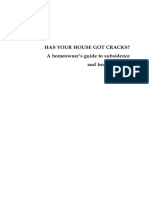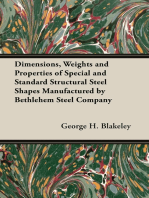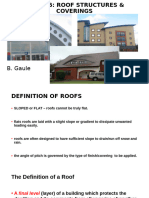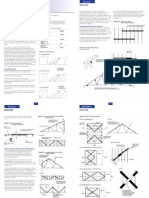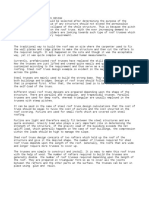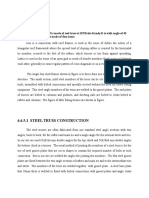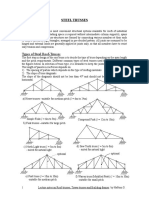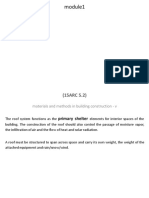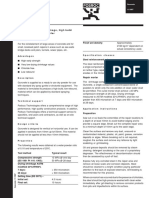Guidelines 11
Uploaded by
Zac Francis DaymondGuidelines 11
Uploaded by
Zac Francis DaymondWHY DO WE BRACE
ROOF TRUSSES?
11
f you want to form a roof
profile with an S shape, as
shown in the photograph,
simply dont brace the roof
trusses correctly.
The only disadvantage with
this procedure is that the roof
may not remain in place for the
design life of the building.
The most common reason for
roof truss failures is missing or
incorrectly installed bracing.
Most people in the building
industry probably assume that
roof truss bracing is only
necessary to prevent the trusses
from being blown over.
However, roof bracing is
actually required to resist three
different types of force, which
could all be acting in
combination. These are:
Those resulting from
external forces such as wind
blowing on a gable end, which
tries to push the trusses over.
Overturning forces which
occur when the roof trusses are
not erected perfectly vertical.
Lateral forces from the roof
battens that, apart from
supporting the roof material, are
also preventing the truss top
chords from buckling.
Varying roof truss profiles,
building shapes, roof materials
and design wind velocities affect
how a roof needs to be braced.
For example, a 45-degree
pitch roof in a 41m/s wind area
will have a significantly higher
wind force on the gable end
than the same span roof with a
15-degree pitch, in a 33m/s
wind area.
This is due to both the larger
gable end area and also the
increased wind pressure.
Similarly, large span concrete
tile roofs produce higher lateral
forces in the battens than small
span steel deck roofs, as the
axial compression forces in the
truss top chords are greater.
Also note that bracing
calculations have been based on
the assumption that trusses are
erected such that no part of the
truss is out of plumb by the
lesser of [height at any
section]/50 and 50mm. If this
tolerance is exceeded, the force
required to prevent the trusses
overturning is significantly
increased.
Similarly, the bow in any chord
shall not exceed the lesser of
[chord length]/200 and 50mm.
by Brett Black
State Engineer
Gang-Nail Australia
Steel-brace is required to have
a minimum end fixing capacity
of 5.5kN (which is a force of
over half a tonne).
Im sure that you would not
be surprised to hear that using
one or two nails to fix the steelbrace to the top of the top plate
does not achieve this
requirement.
Unfortunately, this seems to
occur fairly frequently on site,
and could lead to roof failures in
the long term.
The preferred method of fixing
at the heel end, is to bend the
steel-brace to the side of the top
plate then under the top plate,
fixing with five nails.
Fixing of the steel-brace at the
apex end should also be with
five nails.
Section 4 of AS4440-1997
Installation of nailplated timber
trusses shows these end fixing
details, and provides many other
guidelines and details for the
bracing of roof trusses.
Note that cantilevered trusses
and trusses with end depth (such
as cut-off and half trusses)
require special brace fixing
details to ensure that the force in
the roof bracing is transferred
into the wall bracing.
Just because a roof is standing
today, does not mean it will still
be standing tomorrow.
Houses are generally designed
to withstand the worst wind
speed that is expected every 50
years. This wind speed could
occur in 100 years time, or
tomorrow.
Lateral force in the battens is
increased when this limit is
exceeded.
You need more than a few
pieces of Speedbrace in a roof
to adequately brace it. The brace
must also be properly fixed at
the ends.
That way the forces in the roof
can be transferred into the wall
bracing, then down to the
footings.
Remember, as you would
have heard many times before, a
chain is only as strong as its
weakest link.
Why bother having a steelbrace capable of supporting a
working load in tension of over
500kg, if its end fixing can take
less than 100kg?
You might also like
- Has Your House Got Cracks - A Homeowner's Guide To Subsidence and Heave Damage PDF50% (2)Has Your House Got Cracks - A Homeowner's Guide To Subsidence and Heave Damage PDF169 pages
- Bridge Design Part 2: Design Loads: AP-G51.2-17 (Incorporating Amendment No. 1)100% (5)Bridge Design Part 2: Design Loads: AP-G51.2-17 (Incorporating Amendment No. 1)137 pages
- Standard Bracing For Simple Roofs PDS PDFNo ratings yetStandard Bracing For Simple Roofs PDS PDF4 pages
- Reinforced Concrete Grade Beams, Piles & Caissons: A Practical Guide for Hillside ConstructionFrom EverandReinforced Concrete Grade Beams, Piles & Caissons: A Practical Guide for Hillside ConstructionNo ratings yet
- Dimensions, Weights and Properties of Special and Standard Structural Steel Shapes Manufactured by Bethlehem Steel CompanyFrom EverandDimensions, Weights and Properties of Special and Standard Structural Steel Shapes Manufactured by Bethlehem Steel CompanyNo ratings yet
- ASI Steelwork Fabrication Erection Code of Practice V1.0-Unlocked0% (1)ASI Steelwork Fabrication Erection Code of Practice V1.0-Unlocked168 pages
- CCQQ Construction Contractor Qualification Questionnaire100% (1)CCQQ Construction Contractor Qualification Questionnaire29 pages
- 1 Normal Tower 2 +3M Extn. Only 3 +6M Extn Only 4 StubNo ratings yet1 Normal Tower 2 +3M Extn. Only 3 +6M Extn Only 4 Stub11 pages
- Standard Bracing of Simple Duopitched Trussed Rafter Roofs For Dwellings PublicNo ratings yetStandard Bracing of Simple Duopitched Trussed Rafter Roofs For Dwellings Public4 pages
- Standard Bracing of 'Room in The Roof' (Attic) Trussed Rafter RoofsNo ratings yetStandard Bracing of 'Room in The Roof' (Attic) Trussed Rafter Roofs4 pages
- CONTED2 - UNIT 12 - Double-pitched roofNo ratings yetCONTED2 - UNIT 12 - Double-pitched roof45 pages
- Mild Steel Roof Trusses: To Prevent Secondary Shear and SNo ratings yetMild Steel Roof Trusses: To Prevent Secondary Shear and S2 pages
- Metal Roofs: Introduction To Steel RoofsNo ratings yetMetal Roofs: Introduction To Steel Roofs31 pages
- 6.6.5 TRUSSES: 6.6.5.1 Steel Truss ConstructionNo ratings yet6.6.5 TRUSSES: 6.6.5.1 Steel Truss Construction3 pages
- Lateral Bracing in Steel Roof Trusses PDFNo ratings yetLateral Bracing in Steel Roof Trusses PDF10 pages
- Junior Design Engineer: Satyavani Projects and Consultants Pvt. LTDNo ratings yetJunior Design Engineer: Satyavani Projects and Consultants Pvt. LTD30 pages
- Rar 803: Architectural Structures Module-1 Analysis and Design of Roof Trusses (Steel) PART-1No ratings yetRar 803: Architectural Structures Module-1 Analysis and Design of Roof Trusses (Steel) PART-16 pages
- NC340 - CARPENTRY AND ROOF WORK LEVEL 2 QP NOV 2011No ratings yetNC340 - CARPENTRY AND ROOF WORK LEVEL 2 QP NOV 20116 pages
- Types of Truss Member Sections: Bolted Angles To Form Lightweight, Long-Span TrussesNo ratings yetTypes of Truss Member Sections: Bolted Angles To Form Lightweight, Long-Span Trusses6 pages
- How to Build a Global Model Earthship Operation II: Concrete WorkFrom EverandHow to Build a Global Model Earthship Operation II: Concrete WorkNo ratings yet
- Some Mooted Questions in Reinforced Concrete Design American Society of Civil Engineers, Transactions, Paper No. 1169, Volume LXX, Dec. 1910From EverandSome Mooted Questions in Reinforced Concrete Design American Society of Civil Engineers, Transactions, Paper No. 1169, Volume LXX, Dec. 1910No ratings yet
- Technical Information ASSET DOC LOC 4899132No ratings yetTechnical Information ASSET DOC LOC 489913210 pages
- 5100.1-2017-Scope and General Principles - Unlocked100% (1)5100.1-2017-Scope and General Principles - Unlocked53 pages
- Forensic Analysis of Failure of Retaining Wall: January 2016No ratings yetForensic Analysis of Failure of Retaining Wall: January 20167 pages
- Dalsteel Metals Pty Limited Aluminium Alloy 6063 T6 Extrusions 158No ratings yetDalsteel Metals Pty Limited Aluminium Alloy 6063 T6 Extrusions 1583 pages
- TD008 SuperSlim Soldiers Issue 7 - 01sept15 - UnlockedNo ratings yetTD008 SuperSlim Soldiers Issue 7 - 01sept15 - Unlocked37 pages
- Guncrete: High Strength, Low Shrinkage, High Build Spray Applied Repair MortarNo ratings yetGuncrete: High Strength, Low Shrinkage, High Build Spray Applied Repair Mortar4 pages
- Guncrete: High Strength, Low Shrinkage, High Build Spray Applied Repair MortarNo ratings yetGuncrete: High Strength, Low Shrinkage, High Build Spray Applied Repair Mortar4 pages
- Supapurlin: Analysis and Design of Supa Purlins According To As/Nzs 4600:2005No ratings yetSupapurlin: Analysis and Design of Supa Purlins According To As/Nzs 4600:200513 pages
- Periodic Maintenance Manual - Split UnitsNo ratings yetPeriodic Maintenance Manual - Split Units1 page
- Name: Kartikeya Thadani Reg No.: 19bma0029No ratings yetName: Kartikeya Thadani Reg No.: 19bma00294 pages
- Bridge-Plate: Deep Corrugated Structural PlateNo ratings yetBridge-Plate: Deep Corrugated Structural Plate8 pages
- 1a Domestic Water Meter Installation in Villas and Sheds DrawingPEWSTDAMI001No ratings yet1a Domestic Water Meter Installation in Villas and Sheds DrawingPEWSTDAMI0011 page
- Determination of AASHTO Layer Coefficients For Granular MaterialsNo ratings yetDetermination of AASHTO Layer Coefficients For Granular Materials12 pages
- Earthquake Resistant Design of Building - A Case Study On Modification of Terminal Building at Silchar AirportNo ratings yetEarthquake Resistant Design of Building - A Case Study On Modification of Terminal Building at Silchar Airport12 pages
